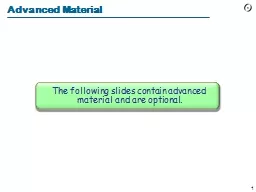

The following slides contain advanced material and are optional Outline Voidsafety Problem of voidcalls A solution to voidcalls Attached types Certified attachment patterns Object test Voidsafety in other languages ID: 262946
Download Presentation The PPT/PDF document "Advanced Material" is the property of its rightful owner. Permission is granted to download and print the materials on this web site for personal, non-commercial use only, and to display it on your personal computer provided you do not modify the materials and that you retain all copyright notices contained in the materials. By downloading content from our website, you accept the terms of this agreement.
Slide1
Advanced Material
The following slides contain advanced material and are optional.Slide2
Outline
Void-safety
Problem of void-calls
A solution to void-calls
Attached types
Certified attachment patterns
Object test
Void-safety in other languages
For detailed information, see
“Avoid a Void: The eradication of null dereferencing”
http://s.eiffel.com/void_safety_paperSlide3
From the inventor of null references
I call it my billion-dollar mistake. It was the invention of the null reference in 1965. At that time, I was designing the first comprehensive type system for references in an object oriented language (ALGOL W). My goal was to ensure that all use of references should be absolutely safe, with checking performed automatically by the compiler. But I couldn't resist the temptation to put in a null reference, simply because it was so easy to implement. This has led to innumerable errors, vulnerabilities, and system crashes, which have probably caused a billion dollars of pain and damage in the last forty years.
By Tony Hoare, 2009Slide4
Problem of void-calls
Entities are either
Attached: referencing an object
Detached: void
Calls on detached entities produce a runtime error
Runtime errors are bad...
How can we prevent this problem?Slide5
Solution to void-calls
Statically attached: checked at compile time
Dynamically attached: attached at runtime
Consistency:
A call
f.x (...)
is only allowed, if
f
is statically attached.
If
f
is statically attached, its possible runtime values are dynamically attached.Slide6
Statically attached entities
Attached types
Types which cannot be void
x:
attached
STRING
Certified attachment patterns (CAP)
Code pattern where attachment is guaranteed
if
x /= Void
then
x.f
end (where x is a local)Object testAssign result of arbitrary expression to a localBoolean value indicating if result is attachedif attached x as l
then
l.f
endSlide7
Attached types
Can declare type of entities as
attached
or
detachable
att:
attached
STRING
det: detachable STRING
Attached types
Can call features:
att.to_upper
Can be assign to detachable: det := attCannot be set to void: att := VoidDetachable typesNo feature calls: det.to_upper
Cannot be assign to attached:
att := det
Can be set to void
:
det := VoidSlide8
Attached types (cont.)
Entities need to be initialized
Detachable: void
Attached: assignment or creation
Initialization rules for attached types
Locals
: before first use
Attributes
: at end of each creation routineCompiler uses simple control-flow analysis
Types without attachment mark
Currently defaults to detachable
In future will be switched to attachedSlide9
Attached types demo
EiffelStudio settings
Declaration
Error messagesSlide10
Certified attachment pattern (CAP)
Code patterns where attachment is guaranteed
Basic CAP for locals and arguments
Void check in conditional or semi-strict operator
Setter or creation
capitalize (
a_string
:
detachable
STRING)
do
if a_string /= Void then a_string.to_upper
end
ensure
a_string
/= Void
implies
a_string.is_upper
endSlide11
CAP demo
Different CAPs for locals and arguments
Void check in contract
Void check in conditional
Setter
CreatorSlide12
Object test
Checking attachment of an expression (and its type)
Assignment to a local
Local is not declared and only available in one branch
name:
detachable
STRING
capitalize_name
do
if attached name as l_name
then
l_name.to_upper
end
ensure
attached
name
as
n
and then
n.is_upper
endSlide13
Object test demo
Object test in body
Object test in assertion
Object test to test for typeSlide14
Stable attributes
Detachaed attributes which are never set to void
They are initially void, but once attached will stay so
The basic CAPs work for them as well
stable
name:
detachable
STRING
capitalize_name
do
if name /= Void then name.to_upper
end
endSlide15
Stable demo
Feature annotations
CAP with stable attributes
Assigning to stable attributesSlide16
Void-safety in other languages: Spec#
Research variant of C#
Adds contracts and non-null types (and more)
Non-null types are marked with
!
String s = null;
String! s = „abc“;
String! s = null;Slide17
Void-safety in other languages: JML
Research variant of Java
Adds contracts and non-null types (and more)
Types (except locals) are non-null per default
String s = null;
String s = „abc“;
/*@ nullable @*/ String s = null;